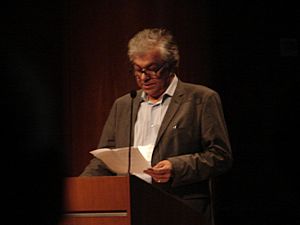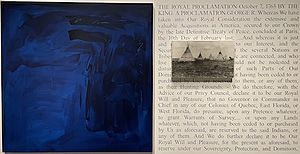Robert Houle facts for kids
Quick facts for kids
Robert Houle
|
|
|---|---|
 |
|
| Born | March 9, 1947 Saint Boniface, Manitoba, Canada
|
| Nationality | Saulteaux First Nations, Canadian |
| Education | BA, Art History University of Manitoba; BE, Art Education McGill University |
| Known for | oil painter, photographer, installation artist, multimedia artist |
|
Notable work
|
The Place Where God Lives (1989), Seven in Steel (1989), Kanata (1992) |
| Partner(s) | Paul Gardner |
Robert Houle RCA (born in 1947) is a famous Canadian artist from the Saulteaux First Nation. He is also a curator, which means he helps organize art shows, and he's a writer and teacher. Since the 1970s, Robert Houle has been very active in the art world. He helped connect modern First Nations artists with the wider Canadian art scene. He did this through his writing and by being involved in important art exhibitions, like "Land, Spirit, Power: First Nations" at the National Gallery of Canada in 1992.
As an artist, Houle's work has been shown both in Canada and around the world. He mostly creates paintings using a style called Abstraction. This means his art often uses shapes, colors, and lines instead of clear pictures. However, he also likes to add everyday images and text to his artworks. His art often talks about the lasting effects of colonialism on First Nation peoples. He sometimes uses old photographs and writings, changing them and mixing them with the Anishnaabe language and traditional materials like porcupine quills.
Contents
About Robert Houle
Robert Houle was born on March 9, 1947, in St. Boniface, Manitoba. His parents were Gladys and Solomon Houle. He was the oldest of fifteen children. His family raised all of them as both Roman Catholic and Saulteaux. For his first eight years of school, he attended residential schools in Sandy Bay First Nation.
Robert Houle's Education
In 1972, Houle earned his Bachelor of Arts degree in Art History from the University of Manitoba. After graduating, he continued to study art. He attended the Salzburg International Summer Academy, where he focused on painting and drawing. In 1975, he earned another degree, a Bachelor of Education in Art Education, from McGill University in Montreal, Quebec. While he was studying at McGill, he also taught art classes at the Indian Way School in Kahnawake.
In 1991, Robert Houle became the first professor of Indigenous Studies at The Ontario College of Art. He taught there for fifteen years. During this time, he guided and inspired many artists, including Bonnie Devine and Michael Belmore.
Robert Houle's Artwork

Robert Houle's paintings have been shown in many important art galleries. These include the National Gallery of Canada and the Art Gallery of Ontario. His work has also traveled internationally to places like the Museum of Contemporary Art, Sydney in Australia. It has also been displayed at the Canadian Cultural Centre in Paris and the Stedelijk Museum in Amsterdam.
In Canada, his art has been featured at many galleries. Some of these include the Mendel Art Gallery, the Museum of Contemporary Canadian Art, and the Winnipeg Art Gallery. His artwork is now part of collections across Canada. It is also found in parts of the United States and Australia.
Robert Houle's Career
From 1977 to 1981, Robert Houle held an important position. He was the first Indigenous curator of contemporary Indigenous Art at the Canadian Museum of Civilisation. This museum is now known as the Canadian Museum of History in Ottawa. His job involved researching and writing about the art already in the museum's collection. He also worked to get new artworks for the museum.
He traveled a lot for his work. He became friends with many other artists, including Abraham Anghik Ruben and Norval Morrisseau. However, the museum's way of working was not always supportive of modern Indigenous art. Robert Houle felt that his work, and the contemporary art he bought, was not being shown properly. After three years, he decided to leave his position. He wanted to focus on his own art and ensure contemporary Indigenous art was seen as important.
Exhibitions and Teaching
Robert Houle has organized and helped organize many important art exhibitions. These include "New Work By a New Generation" in Regina in 1982. He also co-curated "Land Spirit Power: First Nations" at the National Gallery of Canada in 1992. He has been a visiting artist at several places, like Hood College and the Heard Museum. For many years, he taught as an instructor at the Ontario College of Art and Design. He is now retired from teaching.
He was also made a member of the Royal Canadian Academy of Arts. Robert Houle has had a big impact as an artist, curator, teacher, and writer. Because of his influence, he has received many awards. These include the Janet Braide Memorial Award for Excellence in Canadian Art History in 2003. He also received the Toronto Arts Award for the Visual Arts in 2001. In 2015, he was honored with the Governor General's Award for Visual Arts.
Art Collections
Robert Houle's artwork is part of many public art collections. These include the Art Gallery of Ontario and the Heard Museum. His art can also be found at Laurentian University Museum and Arts Centre. Other places that collect his work are McGill University and the National Gallery of Canada.

